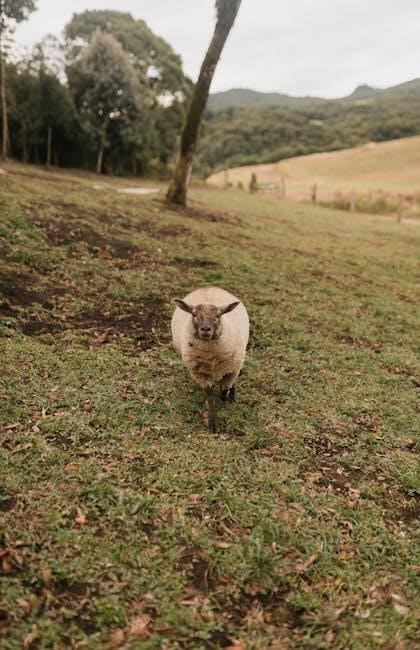Proper wool washing is essential to maintain its softness and prevent shrinkage. Use cold water, mild detergents, and gentle cycles. Hand washing is often recommended, but machine washing on specific wool settings can be safe. Always check care labels and avoid harsh chemicals or high heat to preserve wool’s natural texture and durability.
1.1 Importance of Proper Wool Care
Proper wool care is vital to preserve its natural fibers and maintain softness. Improper washing can cause felting, shrinkage, or loss of texture. Using cold water, mild detergents, and gentle cycles helps protect wool’s integrity. Regular care ensures longevity, prevents damage, and keeps wool garments comfortable and visually appealing. Proper techniques also prevent pilling and maintain the fabric’s natural insulation properties.
1;2 Common Mistakes to Avoid When Washing Wool
Common mistakes include using hot water, harsh detergents, or excessive agitation, which can cause felting or shrinkage. Avoid wringing or twisting wool garments, as this damages fibers. Never use fabric softeners or bleach, and refrain from tumble drying. Ignoring care labels and over-washing are also mistakes that can degrade wool’s quality and texture, leading to a shorter lifespan for garments.
Hand Washing Wool
Hand washing wool is recommended for delicate or hand-wash-only items. Use cold water, a mild detergent, and gentle agitation. Avoid wringing or twisting to prevent damage.
2.1 Step-by-Step Guide to Hand Washing Wool
- Turn the wool garment inside out to protect fibers.
- Fill a basin with cold water and add a mild wool detergent.
- Gently submerge the wool, avoiding agitation or wringing.
- Let it soak for 10-15 minutes to loosen dirt.
- Rinse thoroughly in cold water until water runs clear.
- Remove excess water without twisting or squeezing.
- Reshape the garment and lay it flat to air dry.
2.2 Recommended Water Temperature for Hand Washing
Use cold or lukewarm water, ideally between 30°C and 35°C, to hand wash wool; Hot water can cause felting and shrinkage, while excessively cold water may not clean effectively. Maintain consistent temperatures during washing and rinsing to prevent fiber stress and ensure gentle cleansing without damaging the wool.
2.3 Best Detergents for Hand Washing Wool
Use mild, pH-neutral detergents specifically designed for wool. Avoid harsh chemicals, bleach, or fabric softeners, as they can damage fibers. Wool-specific detergents like Woolite gently clean without stripping natural oils, preserving softness and texture. Always dilute detergent in water before soaking to ensure even distribution and prevent residue buildup on delicate wool fabrics.

Machine Washing Wool
Machine washing wool requires careful attention. Use a gentle cycle with cold water and a low spin setting to prevent felting. Choose a wool-specific program if available, and ensure the detergent is suitable for wool to maintain its softness and prevent shrinkage.
3.1 How to Use a Washing Machine Safely for Wool
Always check the care label to ensure the wool garment can be machine washed. Use a gentle cycle with cold water (max 30°C) and low spin speed. Place wool items in a mesh laundry bag for added protection. Select a wool-specific detergent and avoid fabric softeners or bleach. Never overload the machine to prevent friction and felting.
3.2 Recommended Washing Machine Settings for Wool
Use a gentle or delicate cycle with cold water (maximum 30°C). Select a low spin speed to minimize friction. Choose a wool-specific program if available. Avoid overloading the machine, as this can cause damage. Ensure the settings align with the care label instructions for optimal results and to prevent felting or shrinkage.
3.3 Detergents Suitable for Machine Washing Wool
Use mild, wool-specific detergents that are free from enzymes and bleach. These detergents are designed to preserve wool fibers without causing damage. Avoid regular or biological detergents, as they can degrade wool. For machine washing, ensure the detergent is dispersed evenly before adding wool garments to maintain fabric integrity and prevent felting.

Drying Wool Garments
Air drying is recommended for wool to prevent felting and shrinking. Reshape garments while damp and lay flat away from direct heat. Avoid machine drying.
4.1 Air Drying vs. Machine Drying: What’s Better for Wool
Air drying is better for wool as it prevents felting and shrinking, while machine drying can damage fibers. Lay wool garments flat away from direct heat to maintain shape. Machine drying on low settings is possible but risky. Always reshape damp wool and avoid tumbling to preserve its natural texture and softness.
4.2 Tips for Reshaping Wool Garments While Drying
Lay wool garments flat on a clean towel, away from direct heat. Reshape while damp to restore original form. Gently smooth wrinkles with your hands. Avoid hanging, as it may stretch or misshape the fabric. Use a clean towel to blot excess moisture, ensuring even drying. Air dry completely to prevent shrinkage and maintain the garment’s natural texture and fit.
Special Care for Different Types of Wool
Different wool types require tailored care. Merino wool is machine washable but delicate, while cashmere needs gentle hand washing. Use specific detergents for each type to preserve softness and texture, ensuring longevity and preventing damage. Always follow care labels for precise instructions tailored to the wool variety.
5.1 Washing Merino Wool: Specific Tips
Merino wool is machine washable but requires gentle care. Use cold water, a mild detergent, and a delicate cycle. Avoid fabric softeners and bleach. Tumble drying is not recommended; air drying preserves its texture. Hand washing is also effective—soak in lukewarm water for 10 minutes, rinse gently, and reshape while damp. Always check the care label for specific instructions to maintain softness and prevent shrinkage.
5.2 Caring for Cashmere Wool: Do’s and Don’ts
Cashmere requires delicate care. Hand wash in cold water using a mild detergent, avoiding fabric softeners. Gently agitate, then rinse thoroughly. Do not wring or twist. Reshape while damp and air dry away from direct heat. Avoid machine washing unless a specific wool cycle is available. Store in a cool, dry place to prevent moth damage and maintain softness. Handle with care to preserve its luxurious texture.

Removing Stains from Wool
Act quickly to treat stains on wool. Use a gentle detergent or cold water to blot the area. Avoid hot water, which can damage fibers. Gently agitate, but never rub, to prevent felting. For tough stains, pre-treat with a wool-safe solution before washing. Always test a small area first to ensure colorfastness and fabric integrity.
6.1 Pre-Treatment Methods for Stains on Wool
For effective stain removal on wool, pre-treat by gently applying a small amount of mild detergent directly to the stain. Allow it to sit for a few minutes before gently agitating with your fingers. Avoid using hot water or harsh chemicals, as they can damage the fibers. This step is crucial before washing to ensure stains don’t set in.
6.2 Safe Stain Removal Techniques Without Damaging Wool
When removing stains from wool, use cold water and a mild detergent; Gently blot the stain with a clean cloth to absorb excess moisture. Avoid rubbing, as it can cause felting; For tough stains, apply a wool-specific detergent directly and rinse thoroughly. Never soak wool for extended periods, as it can weaken fibers. Air dry to maintain texture and prevent shrinkage.

Checking Care Labels
Always examine care labels for specific wool washing instructions. Symbols indicate hand or machine washing preferences, water temperatures, and drying methods, ensuring optimal care and preservation of wool garments.
7.1 Understanding Symbols on Wool Care Labels
Understanding care label symbols is crucial for proper wool maintenance. A hand wash symbol indicates gentle cleaning, while a machine wash symbol suggests specific cycles. Temperature markings guide water settings, and a dry flat symbol prevents shrinkage. Familiarizing yourself with these icons ensures you follow the manufacturer’s recommendations, preserving wool’s quality and extending its lifespan effectively. Always check before washing to avoid damage.
7.2 When to Follow Machine vs. Hand Wash Instructions
Always prioritize care labels when deciding between machine or hand washing. Machine washing is suitable for durable wool fabrics on gentle cycles with cold water. Hand washing is best for delicate or cashmere wool items to prevent felting. If unsure, hand washing ensures safety, while machine washing with wool-specific settings can be efficient for tougher wool garments. Choose wisely to maintain quality and texture.

Preparing Wool for Washing
Always check care labels, remove stains, and use cold water with mild detergents. Avoid fabric softeners and bleach to protect wool fibers and maintain their quality.
8.1 Turning Wool Garments Inside Out Before Washing
Turning wool garments inside out before washing helps protect them from friction and snagging. This prevents pilling and reduces the risk of damage to the outer fabric. It also ensures that any loose fibers or dirt are removed without abrading the surface. This step is especially important for machine washing to maintain the garment’s appearance and longevity.
8.2 Sorting Wool Fabrics by Color and Thickness
Sorting wool fabrics by color prevents dye bleeding and ensures uniformity. Separating by thickness avoids abrasion between delicate and heavier fabrics. This step is crucial for maintaining texture and appearance. It also helps in applying the right washing method for different types of wool, ensuring a gentle and effective cleaning process without damage.
Storage Tips for Wool Garments
Store wool garments in a cool, dry place using breathable containers or fabric bags. Natural fibers like cotton or linen help maintain shape and prevent moth damage.
9.1 How to Store Wool Clothes to Prevent Moths
Store wool clothes in airtight containers or zippered bags to prevent moths. Clean garments before storage, as moths are attracted to natural oils. Use mothballs or natural deterrents like lavender sachets. Ensure the storage area is cool, dry, and well-ventilated. Avoid basements or damp spaces. Fold items neatly and consider using acid-free tissue paper for added protection.
9.2 Maintaining the Shape of Wool Garments in Storage
Lay wool garments flat in a cool, dry place to maintain their shape. Use acid-free tissue paper to fill hollows and prevent creases. Avoid hanging wool, as it may stretch. Store in a breathable container or zippered bag. Refold garments occasionally to prevent permanent creases. Clean before storing to avoid moth attraction and musty odors.
Common Questions About Wool Washing
Can all wool garments be machine washed? Typically, no. Check labels for machine washing suitability. Use cold water and gentle detergents to prevent damage and shrinkage.
10.1 Can All Wool Fabrics Be Machine Washed?
Not all wool fabrics can be machine washed. Check the care label; some wools require hand washing or dry cleaning. Machine washing is safe for superwash or machine-washable wools. Use cold water, gentle cycles, and wool-specific detergents to avoid felting or shrinkage. Avoid hot water, bleach, and fabric softeners to preserve wool quality.
10.2 Why Shouldn’t Wool Be Tumble Dried?
Wool shouldn’t be tumble dried due to heat and friction, which cause felting and shrinkage. Heat breaks down natural fibers, leading to loss of softness and shape. Tumble drying can also misshape wool garments permanently. Air drying is safer, preserving wool’s natural texture and preventing damage from high temperatures and mechanical stress.

Using Wool-Specific Detergents
Wool-specific detergents are designed to gently clean without damaging fibers. They protect natural oils, prevent felting, and maintain softness. Regular detergents can harm wool, so always choose specialized formulas.
11.1 Benefits of Wool Detergents Over Regular Detergents
Wool-specific detergents are formulated to gently clean without stripping natural oils, preventing felting and maintaining softness. Unlike regular detergents, they avoid harsh chemicals that can damage fibers. Wool detergents are pH-balanced, ensuring minimal impact on the fabric’s integrity. They also prevent shrinkage and preserve the wool’s natural texture, making them essential for prolonged garment life and environmental safety.
11.2 How to Choose the Right Wool Detergent
Select a detergent specifically designed for wool, ensuring it’s gentle and free from harsh chemicals like bleach or fabric softeners that can damage fibers. Opt for pH-balanced, non-toxic options that preserve wool’s natural oils. Look for certifications like Woolmark approval or labels indicating suitability for delicates. Avoid regular detergents to prevent felting and maintain softness and texture.

Preventing Felting and Shrinking
Wool felts and shrinks when exposed to heat, friction, or harsh detergents. Use cold water, gentle cycles, and wool-specific detergents to preserve texture and size effectively always.
12.1 Causes of Felting in Wool Fibers
Felting occurs when wool fibers mat and tangle due to friction, heat, or harsh detergents. Agitation during washing and high water temperatures break down natural oils, causing fibers to shrink and felt. This process is irreversible, damaging the fabric’s texture and softness. To prevent felting, gentle handling, cold water, and wool-specific detergents are essential to maintain fiber integrity and avoid shrinkage.
12.2 Tips to Avoid Shrinking Wool Garments
To prevent wool from shrinking, wash in cold water with mild detergents. Avoid machine drying; instead, air dry flat. Gently reshape garments while damp. Do not twist or wring, as this causes fibers to contract. Use a wool-specific detergent to preserve natural oils, reducing friction and shrinkage risk. Always follow care labels for best results and to maintain wool’s natural texture and size.

Washing Raw or Unprocessed Wool
Washing raw wool requires gentle care. Use cold water and mild detergents to avoid felting. Soak for 10-15 minutes, then rinse thoroughly. Gently squeeze excess water without wringing to preserve fibers. Avoid hot water and harsh chemicals, which can damage raw wool. Air dry flat to maintain texture and prevent shrinkage. Ensure no agitation during washing to keep wool intact.
13.1 Steps for Scouring Raw Wool
- Sort raw wool by color and texture to prevent tangling.
- Soak in cold water with mild detergent for 10-15 minutes.
- Gently agitate to remove dirt without felting.
- Rinse thoroughly with cold water until clean.
- Squeeze excess water without wringing.
- Repeat if necessary, then air dry flat.
13.2 Differences Between Washing Raw and Finished Wool
Raw wool requires soaking, scouring, and rinsing to remove dirt and lanolin, while finished wool needs gentle hand or machine washing. Raw wool may need multiple washes and specific detergents to prevent felting, whereas finished wool is treated to be machine washable with minimal risk of shrinkage, needing mild detergents and cold water.

Environmental Considerations
Eco-friendly wool washing involves using cold water, minimal detergent, and avoiding harsh chemicals to reduce energy and water usage, promoting sustainability while preserving wool quality naturally.
14.1 Eco-Friendly Ways to Wash Wool
Adopt eco-friendly methods by using cold water, low-energy cycles, and biodegradable detergents. Hand washing reduces energy consumption, while avoiding fabric softeners preserves wool’s natural oils. Line drying instead of tumble drying saves electricity and prevents shrinkage. Using minimal water and gentle care ensures wool remains durable and soft while minimizing environmental impact.
14.2 Reducing Water and Energy When Washing Wool
Opt for short, gentle cycles or hand washing to minimize water and energy use. Using cold water preserves wool fibers and reduces energy consumption. Avoid unnecessary rinses and consider line drying instead of tumble drying. These practices not only protect wool but also contribute to a more sustainable approach to laundry care.
Proper wool care ensures longevity and softness. Use gentle washing methods, cold water, and mild detergents to maintain quality. Avoid harsh chemicals and high heat for sustainable fabric care.
15.1 Summary of Best Practices for Washing Wool
Always wash wool in cold water with mild detergents to prevent felting. Hand washing is ideal, but machine washing on gentle settings with low spin is acceptable. Avoid harsh chemicals, bleach, and fabric softeners. Reshape garments while wet and air dry away from direct heat. Regular care ensures wool remains soft, durable, and retains its natural texture.
15.2 Final Tips for Maintaining Wool Garments
Store wool garments in a cool, dry place to prevent moth damage. Allow wool to rest between wears to recover its shape. Always check care labels for specific instructions. Use wool-specific detergents to preserve softness and texture. Avoid direct sunlight to prevent fading. Regular maintenance ensures wool remains a long-lasting, comfortable, and stylish addition to your wardrobe.
